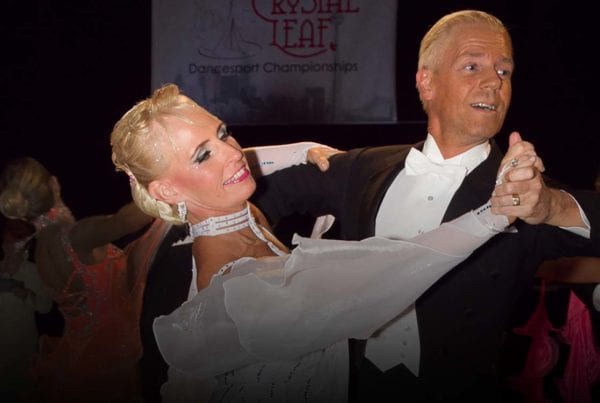As dance teachers, one of the things Wendy and I find ourselves dealing with the most is simply getting partners to understand each other’s perspective and work together.
A huge percentage of dance teaching is about helping ladies understand what the man is dealing with, and helping men understand how their lead affects the lady.
Not surprisingly, ladies are generally better at getting this than men. They are more willing to see the other person’s point of view. They are less likely to have too much pride or ego, though some women do have pretty strong egos and I’ve seen some even bully their partners. The majority of ladies just want to dance, and when their partner does his job well they can freely dance, expressing themselves confidently without having to think.
To do their job, men do need to think, yet they need to dance in a way that pushes the thinking to a secondary part of the experience. That’s not easy! They have to hear and interpret the music, hold their frame, look for space on the floor, plan their next step pattern, communicate this to their partner at the right time for her, then respond appropriately if their lead was misunderstood. On top of all that, they still have to think about their own technique. And they have to do all that while appearing as if they are just out for a stroll in the moonlight, without anything on their mind except the beautiful partner in their arms!
Is it any wonder that women are drawn to men who can dance well?
They have to do all that while appearing as if they are just out for a stroll in the moonlight, without anything on their mind except the beautiful partner in their arms!
The power of ballroom dancing is in its partnership. Two people moving as one to the music. It’s beautiful when done well, a harmonious expression of two very different genders working together to produce something greater than the sum of its individual parts.
Rules for a stronger partnership
Here are a few important concepts that we regularly share with men to make them more aware of how they can be more successful partners. These guidelines apply equally to social dancers, competitors or show dance performers.
First of all, the lead needs to be very clear what step he’s going to lead next. It’s extremely frustrating for a lady to have her signal change halfway through, leaving her wondering what the intended step pattern really is! Know what you want to lead, then stick to it even if ultimately it wasn’t the best choice. Your confidence in the step is what she values more than the step you chose.
Men, you must actively listen to your partner’s body as you dance. It’s no good to simply bully your way through a step group just because that’s what you decided to do. I see this kind of behavior often and I feel so sorry for the poor lady on the receiving end.
It’s no good to simply bully your way through a step group just because that’s what you decided to do
As a leader, our job is to be sensitive to how she responds. We need to be aware of every movement, knowing what foot she is on and where she thinks you are going. Because dance is never perfect. It’s a dynamic, fluid art form that is constantly in flux. You lead, she responds. Then you respond to her response. It’s like a good conversation. If you don’t listen, you’ll quickly be labeled a bore, or worse.
This was one of the first lessons from one of my early Standard teachers, Young Ryu. He drilled it into me that dance is a conversation. Today this ability to listen made me a much better dancer, just as listening in a conversation makes you a welcome and memorable part of the discussion.
Men, you must actively listen to your partner’s body as you dance
Does this make dancing harder? Of course! But since when does any real man shy away from a challenge?
Not only must you plan your next step pattern, you should also keep “contingency” steps in the back of your mind in case something goes wrong. The lady may not open to Promenade Position. Okay, no problem. When you already know what you’ll do if she stays in Closed Position, you won’t get upset and the whole experience will become more enjoyable. For both of you!
And one more thing. We are so frustrated by the trend we’ve been seeing in Latin competition where the male dancers seem unaware that they even have a partner. This is antithetical to the whole concept of partner dancing. In extreme cases, the lead will spend 1:30 of a 1:40 piece of music never even looking at his partner. Of course, in Standard you won’t look at your partner very much for obvious reasons. But in Latin, Rhythm and Smooth, you are connected to your partner through the music, choreography, story and experience. It’s no longer dancing if that partnership is missing from the equation. Look at your partner. Really look at her. Play to the audience if you like but never make that more important than your partner. Let go of all that technical thinking. She doesn’t care about your perfect technique nearly as much as she cares about your connection to her. Express the story of the dance through your connection so that she can enjoy every part of the experience.













“The lady may not open to Promenade Position. Okay, no problem. When you already know what you’ll do if she stays in Closed Position, you won’t get upset and the whole experience will become more enjoyable. For both of you!”
Well, if it is no problem for the capable man, whether the lady opens to PP or not, then why make a problem of something that is no problem.
It’s not necessary in the first place to expect from the lady that she opens to PP. If it’s no problem, then she doesn’t have to.
She is free to decide what she does.
The concept of the man expecting from the lady to do something particular and the lady having to comply to that expectation, is plainly wrong.
Okay so maybe that came across as too flippant. That wasn’t the intention. Of course if led to PP the lady should do so! But when social dancing it can happen, either because of inexperience or inattention, that she doesn’t. What is the man supposed to do now? Stop dancing with her? Stop and start from another position? Scold her in public? My point was that mistakes can happen and when they do, a good lead has options in his back pocket that allow the couple to keep moving without making the partner look or feel like a fool.
Maybe this world will get a new opportunity if we stop thinking of freedoms as mistakes.
THB I’m not sure if you are just trying to instigate, but that is not how dancing works for most people I know.
She expects me to lead her safely through our choreography. When I move my body to signal a change to PP and she does not notice it – it’s completely irrelevant who’s at fault here – I have to move back while leading into the next figure end maybe introduce some unexpected directions and turns to avoid obstacles we would’ve avoided with whatever I planned to dance from PP.
It may not be a problem if my partner does not open to PP (and yes, that happened even at competition), but it is just not optimal for our look.
“The concept of the man expecting from the lady to do something particular and the lady having to comply to that expectation, is plainly wrong.“
Well, my lady doesn’t *have* to do anything, but her trying to follow my suggestions is part of our non-formal contract when dancing together. And afaik that’s true for most couples.
Does your “non-formal contract” include the part where it says that the lady has her own dancing expertise and
1. you have no rights to question the ladie’s decisions while she is trying to follow your suggestions ( = she is analyzing the current situation and based on her expertise decides for a movement as a result with best intention in mind)
2. you have even less rights to imply force to “correct” her decision
?
That’s just a question going through my mind. Isn’t this worth thinking about? Especially when talking about “contracts” which two people agree upon before taking the first step together.
I don’t really know what you’re trying to say here (and George explained better than I could, why), but I will still try to answer your questions, because those answers are pretty clear to my partner and me:
1. I will not question her decision (especially not on the dance floor), but one of us will surely question what led to our missunderstanding afterwards. Usually this includes errors from the two of us.
2. We constantly apply force to each other while dancing (you can use different terms here, but physically speaking it’s just force) both as a result and to influence our movement. This does not include any kind of direct or impliad coercion.
1. Well ok, sure, errors where errors belong. Errors are part of the definition of competition dancing, because errors (or special relations) decide who will get the prize. So of course you will discuss after a competition what could have been done better – I have no problem with that.
Yet I hope that if you happen to be visiting a social event, you don’t feel the need to “discuss the result” of your dancing while or after being there. Because this would surely miss the point of what the intention of dancing activity is all about.
Speaking about harmony it’s relatively clear to me that whenever the idea of “mistake” goes through my head while or after dancing, harmony would be broken in that moment. And of course, where errors are part of the system, the achievement of perfect harmony is excluded by logic.
2. no offense, but if you read the text properly, you will know that I mean the kind of force application which has the “immediately fixing of what went wrong” as sole purpose. So if you don’t do that, we are all perfectly fine.
Best regards
LivingTheDance, I initially thought your first comment was a bit of sarcasm. Then I thought you were talking about the freestyling social dance approach where the partners just kind of make up steps on the fly. Now I don’t know where you’re coming from.
Perhaps you are talking about a different dance form? Your reference to the lady deciding at the moment what move she should do speaks to something other than the worldwide standard of ballroom dances like Waltz, Tango, Quickstep, Slow Foxtrot, Viennese Waltz or even the Latin dances like Rumba, Cha Cha, Samba, Paso Doble, Jive, Mambo, Swing, Bolero or Salsa.
What my post relates to is these traditional partner dances where each partner learns very specific step patterns. Once they know the steps, the couple attempts to perform those patterns in perfect harmony. For this to work, you can only have one driver. Freedom is always possible for the lady, but it has to be within the bounds of the step pattern being performed at that moment or the harmony is lost.
The “contract” that Pfirsicheistee referred to is simply the agreement that the two made at the start of the dance to apply their skills together to try and perform those step patterns in a way that makes the partnership move smoothly and beautifully. If the man leads the lady into one step pattern and she decides on her own initiative to do another one, there can be no harmony.
I have seen social dancers who simply make up steps on the fly as they move to the music and it looks like it must be fun. In such a situation she would of course be free to do whatever she wants at any time, but it’s not ballroom dancing in the same sense covered throughout the posts on this website.
Dear Mr. Pytlik, I’m very fond of your article because it is my real life observation that harmony in dancing is disrupted by those who try to speak without listening. And though this is rather obvious, it’s worth putting emphasis onto the fact, that communication means that you listen what the other is saying and that this is going both ways. Especially when we are concerned about teaching dancing beginners in the world of ballroom dances you just mentioned.
Your example of the lady opening to Promenade Position or not doing so and the man having the skill to recognize both situations and act in a way which allows the dance to continue without disturbing “the looks” can of course be tested within those specific step patterns your dancing is based upon. Let’s take the “Outside Change” (e. g. Waltz) for instance, which is an example that has been technically documented already for a very long time and which is documented with both, the ending in Promenade Position as well as an ending in an Outside Partner position and follow up examples for both cases.
So if you do the Outside Change and the lady opens to PP (let’s say because this is what she would be expected to do) then you continue from PP and if she doesn’t open (for whatever reason) to PP then you continue from an Outside Partner position. So there is no problem here (and as you say, there shouldn’t be), when the man is able to recognize if his partner has opened to PP or not. And – let’s repeat the message – if he does not recognize this, then he is unaware of or lacking an important basic communication skill – the listening.
To make my own point clearer: If the man has the skills to listen and to act according to the given situation, then there is no point in discussing whether the lady opens to PP because the man wants her to do that or whether she does it, because she uses the freedom to choose between different options given in a situation. From my point of view, these are two different ways of thinking about what happens and while experience tells that one of them produces the question “who’s at fault?” more often than not, the other one has good chances to actually produce harmony.
Very nice post. It is very helpful to partners to express their inner self with the help of each other.